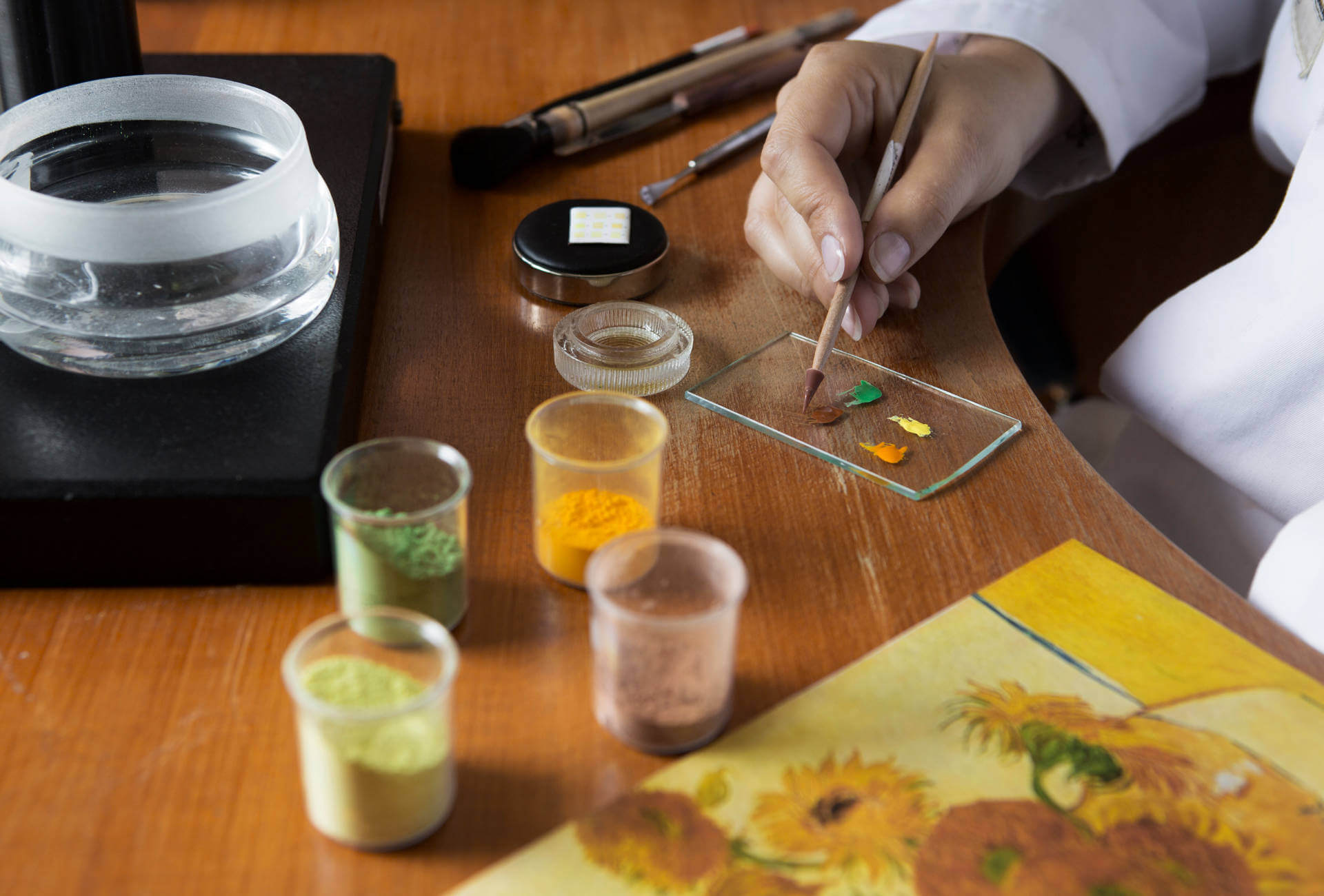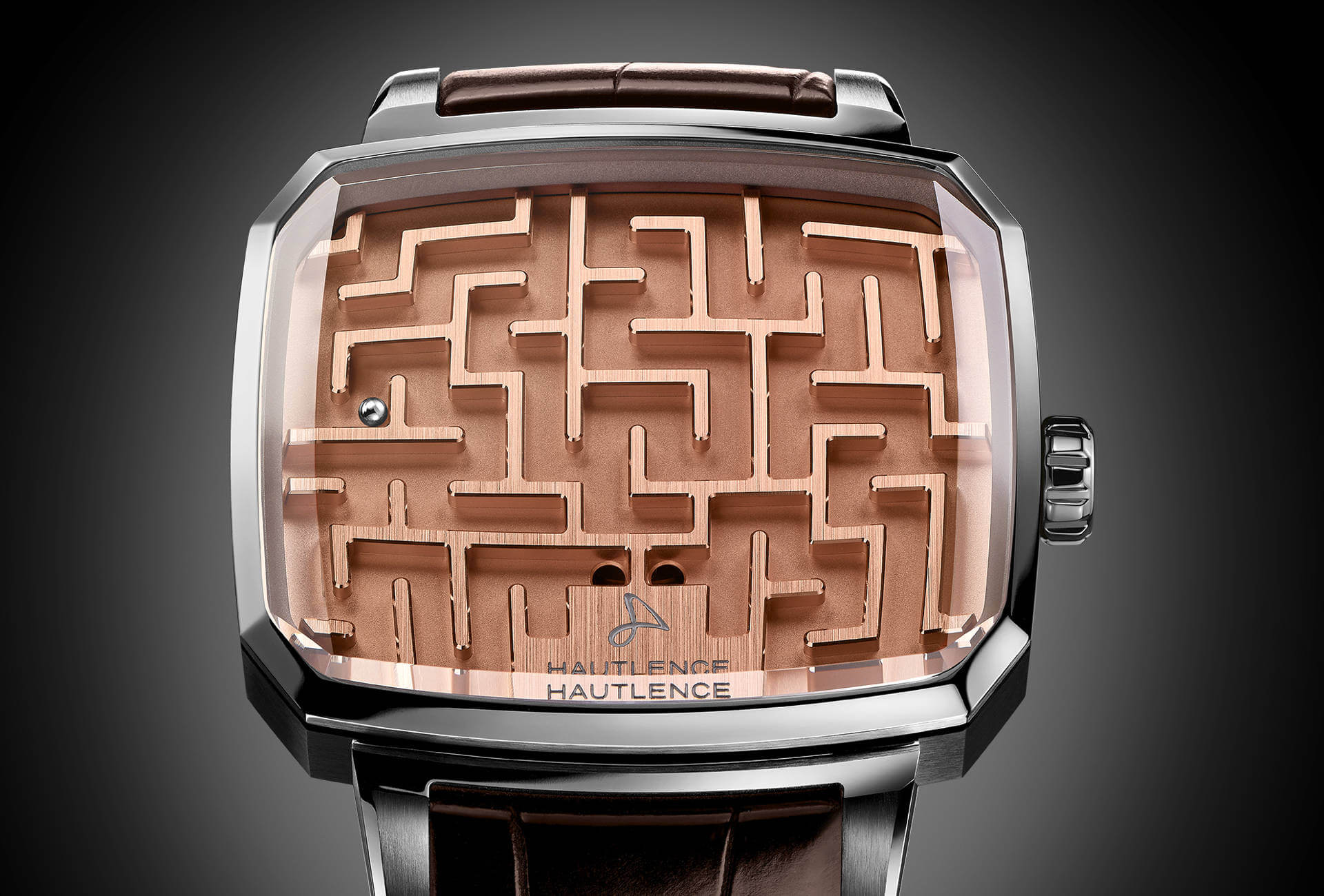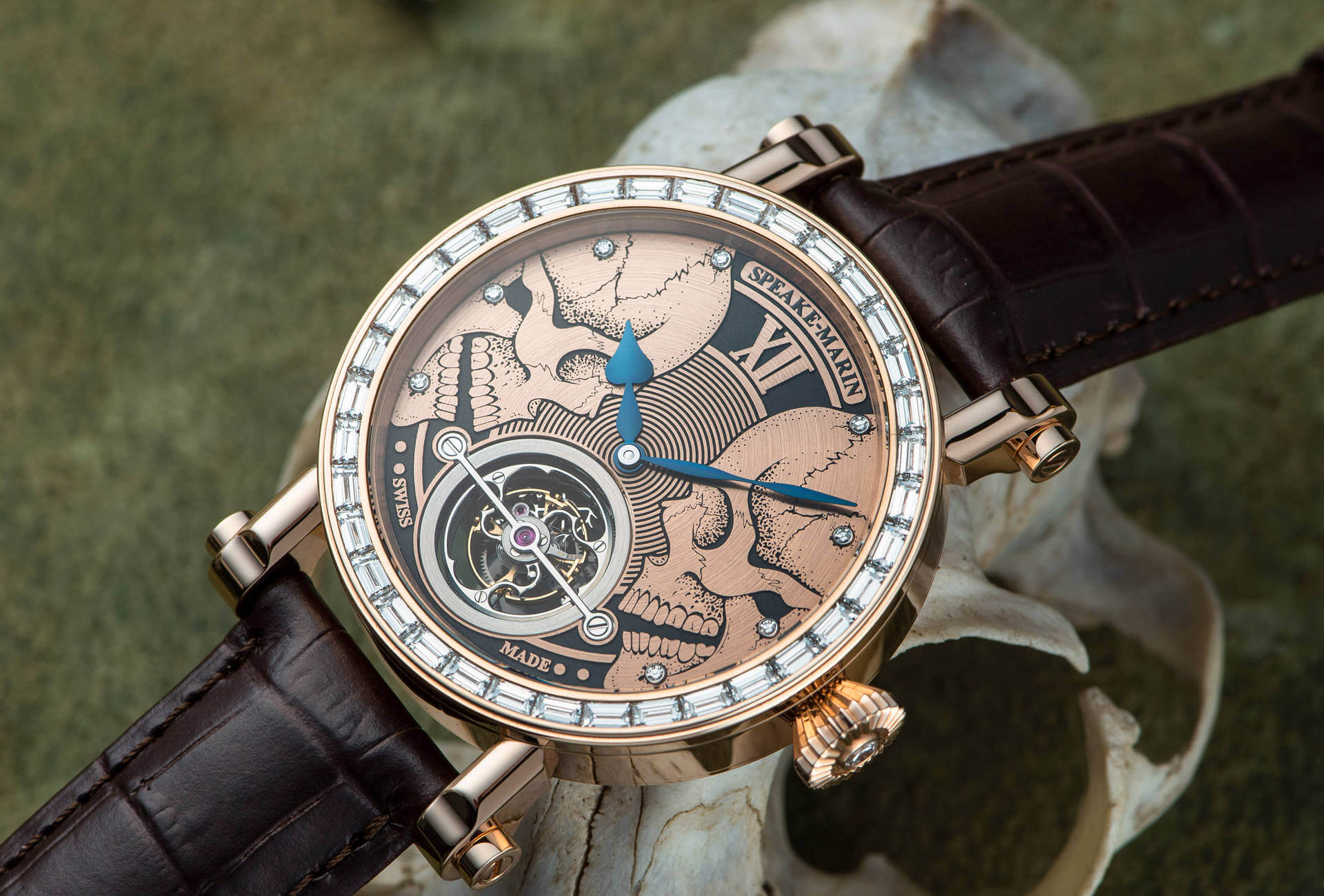Basel is not just the host city of Baselworld and BaselArt; it is also home to an impressive procession of prancing skeletons, the Basel Dance of Death, painted (by whom, no-one knows exactly) in 1440 on the cemetery walls of the Dominican convent in Grossbasel, on the left bank of the Rhine. This extraordinary piece of mortuary art, almost 200 feet long, did not go unnoticed, including across the river where a reproduction was made, between 1450 and 1460, on the Klingenthal convent walls in that part of the city known as Kleinbasel. Which is precisely where Baselworld takes place.
Browsing the aisles of the biggest watch show in the world these past years has revealed an ever more multifarious and colourful profusion of watches embellished with skulls, intertwining bones and more or less complex skeletons: a horological dance of death. Are we witness to a collective memento mori, a debauch of death in atonement for such an overindulgence of luxury? Or is this a sign of the times, a symptom in response to an era replete with sombre caverns where death lurks? But a leopard rarely changes its spots, and certain of these dry bones, hewn from gold, were selling for diabolically high prices.
From its very first day, the mechanical art of time has effectively gone hand-in-glove with death. Because without death there is no time. And without time there is no death. Without death, time has no value the poet would say, convinced a flower’s beauty comes precisely from the fact that it will ultimately fade. Horology is the practical art of enumerating time, and it is in its very nature to relentlessly tally the hours and minutes that remain as we venture ever closer to our ultimate destination, death (ideally, the “counter” that accompanies us as we notch up our three score years and ten will be handed down to our descendants). And so watchmakers have sought to transcend this cavalcade by adorning their timepieces with skulls, skeletons and bejewelled bones. The exact image of our own enduring Vanity, brought back to us by the memento mori.
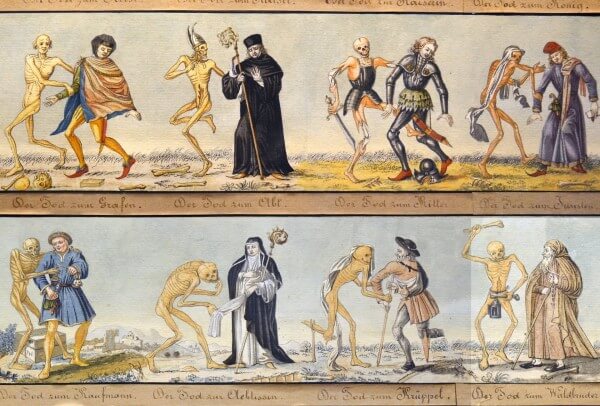
Death, the great leveller
In the Basel Dance of Death, every rank in society, from the highest to the lowest, is gathered into a long and curiously lively procession. We see the preacher, the pope, the emperor and his empress, the king and his queen, each cardinal and bishop, nobility in every guise from the duke to the knight, lawyers and counsellors, physicians, the infirm and the blind, merchants and peddlers, the usurer, the hermit, striplings and other youth, the fool, the executioner, children, cooks and peasants, the Jew, the heathen, the musician, and even the artist who painted them all.
The equivalent today would be to hang a vast canvas at the entrance to Baselworld depicting the CEOs, financial backers, consultants both overt and covert, politicians, ambassadors, bankers, captains of industry, diamond merchants, traders in raw materials, master watchmakers and their retinue, auctioneers, distributors, retailers, collectors and enthusiasts wealthy and poor, knowledgeable and ignorant, designers, CNC operators, publishers, bloggers, photographers, and even the journalist composing these lines.
Pulled by the hand, caught by the neck, pushed along by agile skeletons into the dance of death. Into emptiness.
This year, Baselworld and other venues produced a merry dance of skulls, crossbones and skeletons in more or less full regalia.
There is little chance such a painting should ever see the light of day. It may come as a surprise to learn that we are far more politically correct today than in the late Middle Ages. Beyond the battles that rage on our doorstep, where it reigns “for real” in fire and blood, Baselworld’s dance of death holds sway as a horological, artistic and economic trend which year after year inspires just about every brand to feature at least one skeleton in its closet.
The late Severin Wunderman, he of Gucci watch and Corum fame, was a flamboyant pioneer when he launched his Bubble watches adorned with skulls. He had personal reasons; this self-confessed “world specialist in death” was a compulsive collector of images of the Grim Reaper. He wanted to stand up to death and fight on (almost) equal terms the cancer that was eating away at him. And which ultimately claimed his life.
An endless succession of skulls
This year, Baselworld and other venues produced a merry dance of skulls, crossbones and skeletons in more or less full regalia. Bold skulls at Hublot, black-polished at Richard Mille, a Celtic quartet from Peter Speake-Marin, HYT’s almost radioactive Bad Boy, the gossamer skulls of Fiona Krüger, terrifying green skulls from Bell & Ross, and the malefic “Agonium” Memento Mori, Carpe Diem Watch from Daniel Strom… And many, many more (see them in the accompanying photo gallery).
A trend, a symptom? Of what, exactly? If there is one thing that art and watchmaking share, it is the theme of death.
Art has turned death inside out in its attempt to find some kind of meaning therein. The first ever art was funeral art. As for Death, it could well be Art’s principal subject.
Watchmaking too is congenitally linked to Death. One could even say the watch was created to thwart Death.
When it comes to death, watchmaking and art share the same playing field. Death – time – runs in its blood, one could say.
One (in)famous object proves beyond doubt that Art, Watchmaking and Luxury share this common (burial) ground, and that is Damien Hirst’s skull (2007). A timepiece it is not, but it is the work of a jeweller with the additional and incomparable aura of the pure objet d’art. This platinum cast of an authentic, eighteenth-century human skull – that of a man in his thirties – was set with 8,601 diamonds for a total 1,106.18 carats by Mayfair jewellers Bentley & Skinner (the teeth are original). A memento mori estimated at £50 million that weighs heavy on our minds. The high price of Vanity and a record watchmaking has yet to beat.
But when it comes to death, watchmaking and art share the same playing field. Death – time – runs in its blood, one could say.
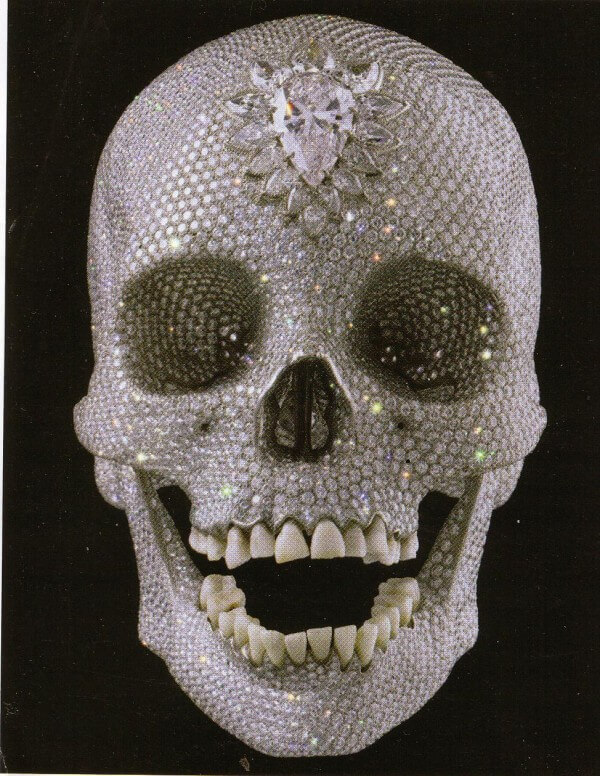
Death, that old, old story
The first memento mori came about at the same time as the portable clock, shortly after the Basel Dance of Death was painted. In L’Horlogerie Macabre, an essay written with Eugène Jaquet, the renowned horological historian Alfred Chapuis notes how “skull watches are the principal manifestation of the macabre in watchmaking: tiny skulls, it must be said, whose diminutive size takes away much of their sinister aspect. One could almost find them, if not amusing, at the very least pleasing objects. Several of them have been artistically engraved, embellished with drawings and inscriptions, while others are adorned with openwork…”
Watches such as these, whether set into a hinged skull or otherwise engraved, can be seen in the collections of every major museum. One of the most appealing for its rigour (mortis), its ingenious opening system, and its sculptural and mechanical qualities is, without doubt, the magnificent watch once carried by Jean Rousseau, citizen of Geneva and grandfather of Jean-Jacques, now on display at the Louvre.
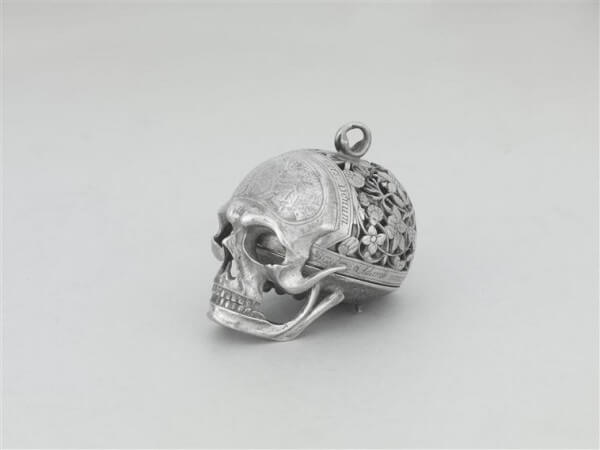
But this is just one example of the countless legions of watches that flirt with the Grim Reaper, and whose number continues to grow in this troubled era. To describe them would take a lifetime.
One hundred years before the Basel Dance of Death was painted, admired, and subjected to endless reproductions, the city was devastated by the Black Death: over half the population lost their lives. Following this, 600 Jews, accused of having started this plague, were burned on an island in the Rhine.
Less than ten years later, in 1356, an earthquake “reduced the town and more than sixty châteaux around it to ashes and ruins.”
You don’t joke around with death.
As our watch is there to remind us. One thing is for sure: from a symbolic and a philosophical point of view, nothing will ever beat mechanics. Is it not the case that the movement of a mechanical watch intrinsically resembles our own skeleton and the subtle mechanics of our bones as they rub together, ready to spring into action?
Only through this consanguinity, no doubt, can watchmaking sometimes become Art.









